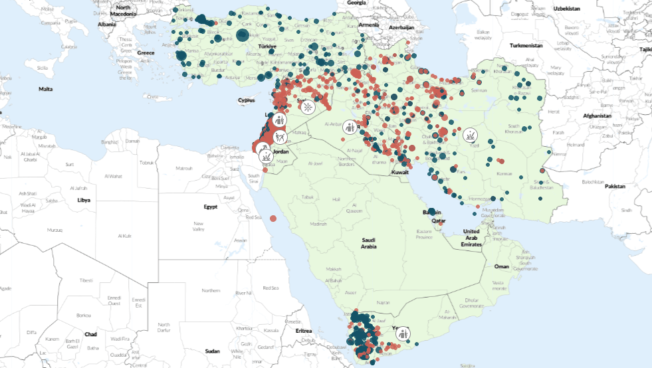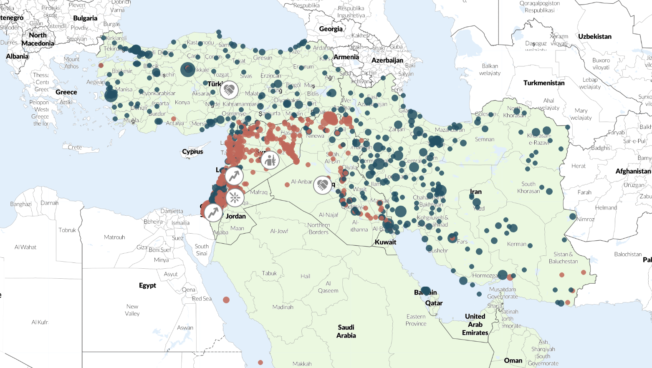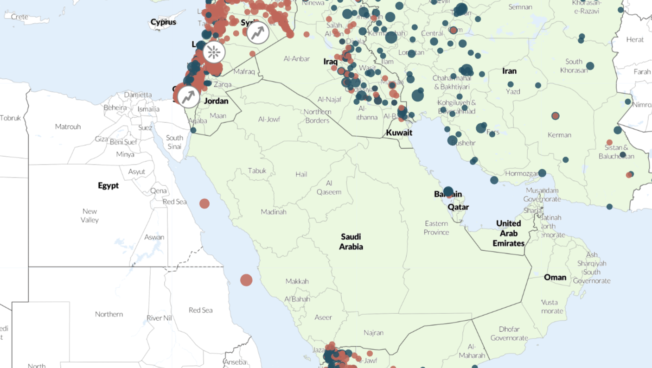Regional Overview
Middle East
July 2025
Posted: 4 July 2025
In this Regional Overview covering June 2025
- Gaza: Surge in aid-related violence and intensifying ground attacks
- Iran-Israel: Unprecedented Israeli offensive on Iran pushes the region closer to a new regional order
- Lebanon, Iraq, and Yemen: Iran’s Axis of Resistance largely remains silent during the war
- Syria: Sectarian violence persists amid fragile post-Assad transition
- West Bank: Settlers attack Palestinians and IDF forces
Gaza: Surge in aid-related violence and intensifying ground attacks
June marked over 100 days since the collapse of the Israel-Hamas ceasefire and was the deadliest month for Palestinians in Gaza since November 2024. At least 665 Palestinian civilians were killed in incidents linked to the delivery of humanitarian aid in the Gaza Strip, accounting for nearly 35% of total recorded deaths in June. This spike coincides with the full rollout of the Israel-backed Gaza Humanitarian Foundation (GHF), run by US contractors and secured by the Israel Defense Force (IDF), established to coordinate and distribute humanitarian aid in Gaza independently of UN agencies, which has transformed humanitarian sites into flashpoints of deadly violence, especially around Khan Yunis and Rafah. On 17 June alone, 90 people were killed across two such incidents when Israeli drones and tanks opened fire on Palestinians waiting for aid trucks; GHF denied that these events took place at its aid distribution site.1Jerusalem Post, “Gaza aid group rejects media claims that dozens were killed at its distribution site,” 17 June 2025
Tensions over aid have also fueled intra-Palestinian violence: ACLED records at least four deadly clashes between Hamas and local clans accused of looting.2Nidal Al-Mughrabi, Jonathan Saul, and Alexander Cornwell, “Battling to survive, Hamas faces defiant clans and doubts over Iran,” Reuters, 27 June 2025 Israel’s backing of alternative actors, including Yasser Abu Shabab’s anti-terror service, has further undermined Hamas’ control and pushed the group toward ceasefire considerations.3Lorenzo Tondo and Jamal Risheq, “From Gaza prisoner to ‘the Israeli agent’: how rise of Abu Shabab could ignite new phase of war,” The Guardian, 10 June 2025 Abu Shabab, a former Hamas prisoner from a prominent Bedouin family, now leads an armed group protecting international aid convoys in southern Gaza.4Tim Lister et al., “Champion of the people or a traitor? A new force emerges in southern Gaza,” CNN, 8 June 2025 Since his release after 7 October, he has emerged as a key player controlling routes near the Kerem Shalom crossing.
Hamas also escalated attacks on Israeli forces operating near buffer zones and aid sites. On 24 June, an ambush in Khan Yunis killed seven Israeli soldiers, the deadliest such attack in recent months. This escalation reflects Hamas’ response to internal pressures and external factors — including aid-related violence and shifting international attention — amid Gaza’s broader humanitarian crisis and local instability.
Despite the worsening situation on the ground, the Israel-Iran ceasefire has seen revived mediation in Gaza. After US President Donald Trump announced on 1 July that Israel had agreed to a 60-day ceasefire in Gaza, Hamas said it was “ready and serious regarding reaching an agreement,” but only if it brings “a complete end to the war in Gaza,” reflecting a cautious willingness by both parties to resume diplomacy.5Fatma Khaled, Samy Magdy, and Bassem Mroue, “Hamas is open to a ceasefire. But Netanyahu says there’s no room for Hamas in postwar Gaza,” The Associated Press, 2 July 2025 However, the outcome of these ceasefire efforts remains uncertain, with no concrete agreement reached and key parties yet to fully commit to the terms under discussion.
For more information, see ACLED Gaza Monitor.
Iran-Israel: Unprecedented Israeli offensive on Iran pushes the region closer to a new regional order
The long-simmering conflict between Iran and Israel erupted into full-blown war on 13 June. Over the course of the 12 days that followed, Israel launched large-scale airstrikes on numerous targets across 27 Iranian provinces, with ACLED recording hits in over 150 distinct locations.
Through an extensive intelligence operation — which involved smuggling short-range missiles and small suicide drones into Iran, as well as setting up makeshift drone factories inside the country6France 24, “Drone factories, camouflaged trucks: Iran releases images of Israel’s covert operation,” 20 June 2025 — Israel was able to swiftly cripple Iran’s air defense radar installations and surface-to-air missile batteries. This allowed Israel to gain control of Iranian airspace from the west to Tehran within days. Israeli fighter jets and drones struck strategic Iranian assets, including ballistic missile infrastructure, IRGC bases and command centers, and nuclear sites — with a particularly high concentration of attacks on Tehran, where ACLED records one-third of the 360 Israeli airstrike events, and in the country’s western provinces. A significant infiltration of Iranian security services allowed Israel to carry out a series of high-profile targeted killings, including the three most-senior military generals, over two dozen other senior commanders, and at least 11 nuclear scientists. Despite Israel’s precise attacks on Iran’s strategic and military assets, a high number of casualties — at least 40% of the more than 1,100 reported fatalities — are estimated by human rights organizations to have been civilians.7HRANA, “Twelve Days Under Fire: A Comprehensive Report on the Iran-Israel War,” 25 June 2025 (Persian)
Importantly, Israel — which had long sought to prompt a US military strike on Iran but failed to do so under successive previous administrations — ultimately succeeded in bringing about limited and targeted US strikes on three nuclear facilities. These included the use of bunker busters that inflicted significant damage on the underground Fordow facility.
Despite Israel’s successful targeting of missile storage sites and launchers in western Iran, Iran was still able to launch over 500 long- and medium-range missiles into Israel.8Emanuel Fabian, “IDF: Sunday’s Haifa impact was not a failed interceptor, but undetected Iranian missile,” Times of Israel, 23 June 2025 ACLED records 36 direct hits inside Israel, resulting in 28 reported fatalities — mostly civilians — and over 3,000 injuries.
While hostilities were halted following Trump’s ceasefire announcement on social media — issued after Iran’s restrained and highly telegraphed retaliatory attack on al-Udeid Air Base, which houses US troops, in Qatar — tensions remain high. Israeli and US strikes inflicted extensive damage on Iran’s nuclear facilities but fell short of achieving their complete destruction.
Although Iran’s missile capabilities were significantly degraded, the threat Israel perceives from Iran — which it views as the primary backer of anti-Israel groups — remains unresolved for the long term unless Iran changes course. Israel’s maximalist approach suggests that it may be only a matter of time before another strike. Much will depend on the trajectory of diplomacy and Iran’s willingness to make concessions on its nuclear program, missile development, and regional policies.
Lebanon, Iraq, and Yemen: Iran’s Axis of Resistance largely remains silent during the war
Israel’s attack on Iran was significantly facilitated by the weakening of its regional partners, which Israel correctly calculated would not provide meaningful support.
Hezbollah, long viewed as a key strategic asset near Israel’s border that gave Iran leverage and deterrence, was unable to intervene in support of Iran. With its military capabilities severely curtailed following last year’s heavy Israeli bombardment and the loss of senior leadership, Hezbollah continues to grapple with domestic political pressure and sustained Israeli precision strikes that have limited its ability to regroup. Israel has conducted more than 600 strikes on Lebanon since largely withdrawing from the south in mid-February. In June, these included an Israeli drone strike that killed the head of Hezbollah’s artillery unit in the south on 18 June, and strikes on the group’s underground assets on 20 June. With the collapse of Iran and Hezbollah’s strategic ally in Syria last December, the group will continue to face significant rearmament challenges.
Despite their long-standing ties to Tehran, most Iran-aligned militias in Iraq maintained a posture of restraint during the Iran-Israel war in June. While groups like Kataib Hezbollah and Harakat al-Nujaba threatened to target US bases and diplomatic sites if Washington deepened its involvement, they only carried out limited drone activity near US facilities in Ain al-Asad and Erbil. Some sources indicated that Iran deliberately held its Iraqi allies in reserve to avoid overextension and further drawing the US into the conflict.9Dana Taib Memmy, “Will Iraqi militias join the Iran-Israel conflict as tensions grow in the region,” The New Arab, 17 June 2025. The Iraqi government also reportedly firmly urged the Iraqi militias not to engage.10Robert S. Ford, “Iraq tries to assert state authority during crisis,” Middle East Institute, 26 June 2025 More broadly, however, these groups have become increasingly independent from Iran in recent years and are now more deeply embedded in Iraq’s political structures — power and economic leverage they risk losing if Iraq were to be drawn into a wider war.11Louisa Loveluck and Mustafa Salim, “Why powerful pro-Tehran militias in Iraq stayed quiet amid Iran conflict,” The Washington Post, 25 June 2025 With legislative elections scheduled for November, these armed groups may now be focused on securing greater political influence, viewing the electoral arena as a key battleground in their pursuit of power.
Houthi forces in Yemen also maintained a relatively restrained posture during the Iran-Israel war. ACLED records a 31% decrease in Houthi attacks targeting Israel compared to May, with 15 incidents logged — the lowest monthly total since March. Notably, no new attacks on US warships in the Red Sea were recorded for the second consecutive month, reflecting continued adherence to the informal US-Houthi ceasefire declared on 6 May (for more on the US campaign targeting the Houthis, see this Regional Overview). The decrease came in spite of two limited retaliatory attacks by Israel against Houthi targets: On 10 June, Israeli naval forces shelled the port of al-Hudadya — the first documented naval strike by Israel in Yemen — and on 14 June, an Israeli airstrike in Sanaa reportedly wounded Houthi Chief of Staff Muhammad al-Ghamari, the most senior Houthi figure targeted by Israel to date.
This lull in hostilities appears driven by both military and strategic considerations. Sustained US airstrikes since early 2024 have significantly degraded Houthi missile infrastructure and command capabilities.12Hussam Radman, “A preliminary evaluation of the American campaign in Yemen,” Yemen Window, 26 March 2025 At the same time, the group may be opting to conserve its resources and preserve its symbolic status as the most active member of the Axis of Resistance by avoiding premature escalation (for more on the Houthis’ goals in light of recent regional escalations, see this ACLED report).
Syria: Sectarian violence persists amid fragile post-Assad transition
On 22 June, a militant detonated an explosive device inside the Saint Elias Church in the al-Dwela neighborhood of Damascus, killing at least 25 civilians and injuring around 60. A previously unknown group, Saraya Ansar al-Sunna, claimed responsibility, citing retaliation for efforts to block religious proselytization near the church in prior months. Syrian authorities blamed the Islamic State (IS), conducted raids, and arrested several suspects. IS has not officially claimed the attack. The sudden appearance of Saraya Ansar al-Sunna has prompted speculation that it may be a front for IS, a splinter of Hayat Tahrir al-Sham (HTS), or a new actor exploiting the current security vacuum.13Aaron Y. Zelin, “The Damascus Church Attack: Who Is Saraya Ansar al-Sunnah?” The Washington Institute, 25 June 2025
The massacre revealed the dangers of sectarian violence in transitional Syria. Since the fall of the Assad regime, ACLED has recorded 13 attacks targeting Christians and their property in Syria, perpetrated by a range of actors including the Syrian Democratic Forces, the newly established Syrian authorities, and now Saraya Ansar al-Sunna. However, the Christian community is not the only minority group under threat. A rise in sectarian violence has been felt across Syria, and the Alawite community has been the most common target. ACLED records 22 attacks against Alawites in June alone that reportedly resulted in the deaths of 33 civilians.
West Bank: Settlers attack Palestinians and IDF forces
Five months after the launch of Operation Iron Wall, overall levels of violence in the West Bank reached their lowest monthly levels in a year, with just 600 events recorded in June. The lull is largely a reflection of Palestinian armed groups’ declining activity, while settler violence continues unabated. In one of the deadliest incidents this year, around 100 masked settlers, some of them armed, attacked the Palestinian village of Kafr Malik on 25 June. They set fire to several houses and vehicles during the assault. IDF soldiers killed three Palestinians and injured seven more when they opened fire on Palestinians who were throwing stones and, according to the official Israeli account, firing shots14Hagar Shezaf, Yaniv Kubovich, and Noa Shpigel, “Six Settlers Arrested for Assaulting IDF Troops in West Bank; Netanyahu: Bring Them to Justice,” Haaretz, 28 June 2025 in an attempt to drive back the settlers.
These events reflect a broader trend in which settler violence has been shifting from covert nighttime operations to broad-daylight rampages on Palestinian villages by large, increasingly organized and well-armed groups of settlers.
Following the attack, Israeli soldiers cleared the illegal outpost from which settlers had launched the assault, prompting returning settlers to attack IDF troops on 28 June, injuring several troops. Settlers also vandalized a military base near Ramallah, setting fires and clashing with troops. Reflecting a growing sense among extremist settlers that they are effectively above the law, these attacks follow two similar incidents of settler violence targeting IDF troops in April and May, with a further 15 such incidents reported in 2024 — up from nine in 2023.
A culture of impunity reinforced by recent government policies, such as ending administrative detention for settlers and openly supporting even the most extreme hilltop and farm outposts,15Neomi Neumann, “ Settler Violence Is Turning the West Bank Into a Tinderbox,” Washington Institute, 18 April 2025 continues to embolden violent actors. In this context, even rare attempts at law enforcement that conflict with settler interests can spark further violence — whether against Palestinians or Israeli soldiers themselves.
See More
See the Codebook and the User Guide for an overview of ACLED’s core methodology. For additional documentation, check the Knowledge Base. Region-specific methodology briefs can be accessed below.
Links:
For additional resources and in-depth updates on the conflict in Yemen, check our dedicated Yemen Conflict Observatory.







